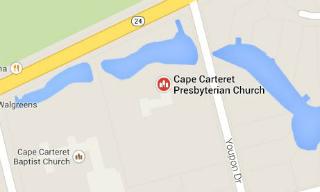Reprinted from the Tideland News
CAPE CARTERET — After more than a year of intense planning and several years of discussion, work is likely to begin by Nov. 15 on the first phase of a project to transform two eyesore ponds in Cape Carteret in western Carteret County into an aesthetically pleasing stormwater management system that should improve water quality in Deer Creek and Bogue Sound.
Supporter Spotlight
Lexia Weaver, a coastal scientist for the N.C. Coastal Federation, said the initial work at the ponds, on property owned by Cape Carteret Baptist and Cape Carteret Presbyterian churches off N.C. 24, will involve slowly draining the ponds and installing drainage pipes under Yaupon Drive. The federation is paying for the project.

The planning board reviewed the plan for the project Tuesday and voted 4-1 to send it on to the board of commissioners along with an addendum it asked the project engineer, Kris Bass, to provide after board members discussed several issues with him in a conference call during the meeting.
The addendum is to include plans for construction entrances at both ends of the project site – intended to help keep mud off town streets – and provisions for measuring the turbidity and depth of Deer Creek before, during and after the project. The ponds discharge into the creek, which is considered “impaired” under the federal Clean Water Act because of bacterial contamination from stormwater runoff. The state doesn’t allow shellfishing in the creek.
Planning board member Paxon Holz brought up the issues about the creek’s turbidity and depth. She told the board that she was expressing the fears of residents at Cape Point, a subdivision along Deer Creek. Even though the project is designed to improve its water quality, Holz said, the residents are worried about what might happen during the construction and what would happen if the project isn’t successful.
Holz voted against sending the plan to the town commission. She said that although she is a federation member, is “greener than anyone here thinks” and understands the need for the project to get moving in order to meet a springtime vegetation planting schedule, she felt rushed and wanted more time for review.
Supporter Spotlight
Weaver noted that the town had the plan for months, but Holz said the planning board itself had not had it until the last month or two. The plan had been reviewed by Brandon Hawks, the planning director, code enforcement officer and building inspector, but Hawks left the town last month to take a similar post in his native Surry County.
John Ritchie, the planning board chairman, pushed for the construction entrances, and also asked that the plan addendum include details on how the federation plans to keep sediments out of Deer Creek during the work. He also had zoning concerns. The area is zoned residential.

Weaver, who also noted that the town approached the federation about the project, pointed out that the residents of Cape Point had the opportunity, as did everyone else, to comment on the project for a month after the federation applied for the state Coastal Area Management Act major development permit it needed for the work. The federation got that permit, as well as all the others it needs, she said, after a stringent review process.
Ritchie also noted that the Cape Point Homeowners’ Association had been notified of the planning board meeting but did not send a representative.
He said he was generally satisfied with the comments and commitments made by the engineer during the conference call set up by Weaver during the meeting, and urged that residents of the subdivision help with the creek monitoring, since the federation, a nonprofit group, is voluntarily spending as much as half a million dollars on the project, which it undertook to help a neighboring town with an eyesore and to address water quality issues in a town creek. The federation is based in Ocean, a community less than 10 miles east of Cape Carteret on N.C. 24.
Once those ponds are drained over the winter, the federation will plant wetlands vegetation in the basins, and will install an innovative underground system that will connect one pond to the other.
In the end – before summer 2016, Weaver hopes – the system will effectively treat the stormwater that drains from the church properties, as well as from the highway and from shopping center properties across the street, improving the water quality in Deer Creek, which flows into the fragile shellfish waters of Bogue Sound.
Excavation of the muck in the ponds, as well as the vegetation that’s in them, will begin in late winter, probably in February 2016.
All of the work, according to Weaver, was initially supposed to cost about $200,000, but it might now exceed $400,000 and might approach $500,000. The federation views it as a good deed for the town, and for the creek and the sound.
“The creek has been closed to shellfishing for a long time and the hope is that someday shellfish harvest might be allowed again,” Weaver said in a recent interview. “There is no guarantee that will happen. But at the very least, we know that every bit of help we can provide for Bogue Sound is a good thing.”

The federation has worked with the town and has obtained all the necessary permits from the state, a process that took longer than expected. Because of that work, the federation, the town and the churches had hoped would be done this year now must wait for the spring planting season.
All told, the federation expects to put in more than 18,000 plants, ranging from wetlands grasses to small trees suitable for the habitat, Weaver said.
The stormwater will first enter the smaller upper — farthest from Deer Creek — of the two basins, on the Baptist property. This pond will be reconstructed to have sand and rock layers below the planted vegetation and will serve as a bio-retention area, filtering as much of the pollutants as possible from the collected stormwater.
The water that remains will flow to the larger basin on the Presbyterian property. And the real innovation, Weaver said earlier this year, is that this part of the system will be a tidal salt marsh.
“The idea,” Weaver said, “is not to keep them as ponds; they should be dry most of the time, except when it rains a whole lot.”
The area around the former ponds will be landscaped and attractive; the whole project had to be designed to satisfy the concerns of the churches’ officials, as well as town commissioners.
Andy Wood, a well-respected conservationist in southeastern North Carolina, will trap, remove and relocate snakes, frogs, nutria and whatever else might be in the ponds.
“Andy will find suitable, similar habitat for whatever’s in there,” Weaver said.
And some of that trapping and relocation could begin soon, as the draining of the ponds undoubtedly will alter the habitat to the point where the life will want to – and need to – go elsewhere.
A conservation easement allows the churches to install benches, walkways, bridges, plantings and other amenities that would make the pond areas suitable for worship and other passive uses, but still maintain the former pond sites as natural areas.
Cape Carteret Mayor Dave Fowler said he’s pleased. “I’m happy with where we are,” he said last month. “I know it’s been a while, a long process, but I think everyone is going to be pleased. It’s going to look good for the people who go to the churches, and to people who live in town and drive by there and to people who visit us. It’s going to be a big improvement.”
He’s also excited about what it will do for the ecology. The town, he said, wants to do what’s right for the environment, and improving water quality in Deer Creek, and at least indirectly in Bogue Sound, is a good step in the right direction. In addition, Fowler said, the project will serve as an example for how to take a problem and turn it into asset.
“It can serve as kind of a living outdoor classroom for students,” the mayor said. “It’s good for the kids to be able to see something like this” right across N.C. 24, almost from White Oak Elementary School, which has worked with the federation in the past on ecological projects.
Fowler said he’s glad everyone involved has been patient. “There are a lot of stakeholders involved in this project, and I’ve very pleased with the cooperative efforts by the federation, the town and the churches,” he said.
It has, indeed, been a long time coming. Longstanding problems with the ponds were exacerbated in November 2012 when a water control structure failed and the water drained into Deer Creek. Cape Carteret officials contacted the federation to see what could be done, and the organization suggested that the ponds be turned into wetlands.
Weaver said the federation still hopes the project won’t cost quite as much as it now appears it might. One major factor in the soaring cost has been rock – there’s a lot of it involved – but there’s a chance prices will fall by the time it’s purchased. The plants and labor to install them will probably cost $50,000.
But Weaver said that once all the work is done, it should it integrate well with other efforts in the area.
“We’re also doing some restoration oyster habitat restoration work at two private properties on Deer Creek, in Cape Point,” she said. “That will help, too, and we’re working on a Deer Creek watershed restoration plan and hope we can get some EPA money to do some more work.”







